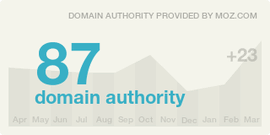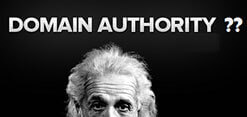
Domain Authority, otherwise known as DA, is a very misunderstood concept in the search engine optimisation community, even among experienced SEO practitioners. Domain authority is calculated by the number of linking root domains in combination with the number of total links that point to a given domain. Moz has created these domain metrics in an attempt to understand and quantify the potential power and influence of a given domain name.
Domain Authority and Page Authority (PA) like all domain measurement metrics, can be manipulated. Moz has publicly stated that their DA & PA domain metrics algorithm has difficulty defining and coping with spammy backlinks. In a recent test I conducted, that was perfectly timed with a Moz DA update; I was able to boost the authority of a brand new domain to DA72 and PA68 in less than 50 days.

This was achieved with five simple 301 redirects and a small bunch of automated backlinking. Now on the surface that domain looks great with those stats but I wouldn’t wish that domain upon anyone. When evaluating domains, look for a nice even spread of metrics across the board. If one single metric is unusually high or low, then this is a signal that something is amiss.
Referencing PR in any way when dealing with domains in 2017 is utterly useless as there hasn’t been a Toolbar PR since December 2013. If your domain has a Toolbar PR5, then in all reality it may actually be a PR0 for all you know, as Toolbar PR updates have been switched off. I talk more about Page Rank at length here.
 Page Authority (PA) and Domain Authority (DA) should be cross-referenced with Topical Trust Flow if you want an accurate analysis of the quality of a domain name. For competitive keywords you’ll always find plenty of sites on the second page with DA40+ and PA40+, but as you analyse the topical trust flow of those sites you’ll see that it’s not on topic. That’s why, despite the high domain stats, the site just isn’t performing in the search results.
Page Authority (PA) and Domain Authority (DA) should be cross-referenced with Topical Trust Flow if you want an accurate analysis of the quality of a domain name. For competitive keywords you’ll always find plenty of sites on the second page with DA40+ and PA40+, but as you analyse the topical trust flow of those sites you’ll see that it’s not on topic. That’s why, despite the high domain stats, the site just isn’t performing in the search results.
Take a look at these examples to see if you can find the safest domain to use for a nice long term Whitehat PBN site (gotta love the irony of that statement). Now remember to forget about the page rank as it’s utterly useless. The PR6 in the below list is maybe a PR0 at the moment for all we know. It’s easy for people to get thrown off by the PR stats of a domain, but Toolbar PR hasn’t been updated in two years so why even bother looking at it. Let’s also assume that the anchor text profiles are all the same with equal and acceptable anchor text distribution.
site1.com: DA55 PA63 | TF16 CF16 | PR0
site2.com: DA17 PA15 | TF31 CF19 | PR2
site3.com: DA18 PA13 | TF12 CF19 | PR5
site4.com: DA29 PA27 | TF11 CF12 | PR6
site5.com: DA27 PA24 | TF22 CF28 | PR2
There are Plenty of DA75+ that Can’t Even Rank 1st Page
site1.com – DA55 PA63 | TF16 CF16 | PR0: Yes, the DA & PA are impressive, but the low trust flow in comparison to the domain authority is a telling sign that the DA is comprised of spam. A clean domain with a DA50 should have a minimum Trust flow of at least 25.
site2.com – DA17 PA15 | TF31 CF19 | PR2: like all metrics, Trust Flow can also be manipulated. Although these domain examples present some borderline cases, the surface metrics of this domain also present cause for concern. Having Trust Flow metrics of 31 accompanied by a DA of only 17 also raises an alarm bell. Yes, a lot of further investigation would be required for this domain to try and ascertain the reason for the low DA. It could just be that the Moz bot (dotbot) hasn’t picked up on all of the links yet, or they are actively being blocked. But a site with TF31 should be at least a DA30.
site3.com – DA18 PA13 | TF12 CF19 | PR5: This is a typical mistake because the high PR throws off most amateur Seo’s. Those TF and DA metrics are what’s to be expected of each other, but they’re not consistent with what you’d expect to find for a domain with a PR5. In scenarios like this you need to be on the lookout for sneaky 301’s pointing to the domain that previously artificially inflated the sites PR. 301’s can sometimes be difficult for all of the backlink analysis services to find. An over inflated page rank can be indicative of an old 301 that used to point to the site.
Nothing Boosts Domain Authority Like 301’s
 I’ve seen many scenarios in the search results were I know that competitors are using a couple of strong 301’s to boost their rankings. But in about 50% of occasions services such as Ahrefs, Majestic and Moz, just can’t seem to find those 301’s. Both the target site and the 301 site can be blocked from the backlink analysis bots via .htaccess. But the sites linking to the original 301 domain can’t be blocked, so it’s surprising to see these services unable to find the source of the redirected 301 domains.
I’ve seen many scenarios in the search results were I know that competitors are using a couple of strong 301’s to boost their rankings. But in about 50% of occasions services such as Ahrefs, Majestic and Moz, just can’t seem to find those 301’s. Both the target site and the 301 site can be blocked from the backlink analysis bots via .htaccess. But the sites linking to the original 301 domain can’t be blocked, so it’s surprising to see these services unable to find the source of the redirected 301 domains.
Understanding Metrics is Easy Once you Know How
site4.com – DA27 PA27 | TF11 CF12 | PR6: For this domain there’s an issue with the trust flow. There is no way that a site with a DA27, which also used to be a PR6 would have a Trust Flow of only 11. That’s the reason it’s hard to fake good domain metrics across the board because one of the metrics will always stick out and give it away.
site5.com – DA27 PA24 | TF22 CF28 | PR2: In this face value comparison site 5 is a clear winner. All of its five metrics are consistent with each other, and nothing is too far out of range. It doesn’t have the strongest DA, TF (or old useless Toolbar PR), but it’s probably the highest quality domain of the five examples.
